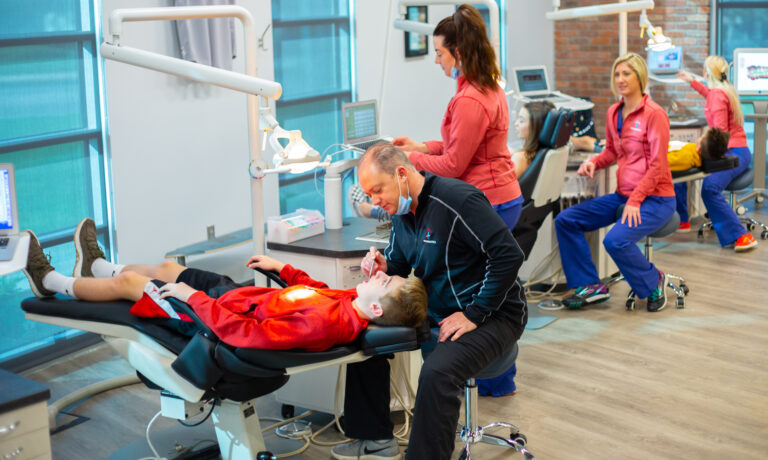Invest in your teen
The teen years (between the ages of 12 and 16) are the most common time for orthodontic treatment because most permanent teeth will be in place. Luckily, some new solutions work to make the treatment process much easier than ever before.
All about teen orthodontics
Experienced orthodontists like Dr. Wood can easily recognize issues with spacing, crowding, bite, and alignment in this age range, and your teen’s bone and jaw structure are formed enough to allow orthodontic treatment to begin. Beyond outward appearances, untreated dental problems can have a lasting impact on your teen’s oral and overall health.
If you notice any of the following issues, we recommend a complimentary consultation with Dr. Wood at Oread Orthodontics, since they could be signs your teen may benefit from orthodontic treatment.
- Early, late, or irregular loss of their baby teeth
- Difficulty with chewing or biting
- Crowding or extra spacing between teeth
- Jaws that shift or make sounds
- Frequent biting of the cheek or the inside of the mouth
- Teeth that meet abnormally or not at all
- Jaws and teeth that are out of proportion to the rest of the face
- Protrusion of teeth
Some teens may have started Phase I treatment at an earlier age, and are now may need to follow it up with full braces or other orthodontic treatment.


Bad bites
Diagnosing and successfully treating certain bite problems can have short-term and long-term benefits.
Problems classified as “bad bites” can often be minimized with the proper orthodontic treatment, including:
- Crooked or crowded teeth
- Missing or extra teeth
- An overbite or underbite
- Incorrect jaw position
- A disorder of the jaw joint
Benefits of a straight smile
Straight teeth that respond well to orthodontic treatment have many benefits, including:
-
Being less prone to wear and tear, chipping, and tooth trauma
-
Improving proper chewing and digestion of food
-
Being easier to keep clean, helping to prevent tooth decay and cavities
-
Reducing the chance of gum disease, which can result in bone loss, decay, and tooth loss

-
Invisalign® Teen
Invisalign® Teen uses customized clear aligners made of soft plastic, which are nearly invisible and comfortable to wear. Your teen will switch aligners each week, gradually shifting their teeth into the desired position. Invisalign is best for mild to moderate orthodontic issues and may not be suitable for severe cases.
-
Clear braces
Clear braces work the same way metal braces do but feature brackets made of tooth-colored ceramic materials. They blend in with your teen’s smile, making them much less obvious. Since ceramic braces are slightly more prone to breaking, and a little costlier than metal braces, they may not be best for everyone.
-
Metal braces
Braces have come a very long way, even within the past decade. When many people think of braces, they think of overly bulky metal brackets, which we don’t use. Modern braces are lighter and more comfortable than ever before.
FAQs about teen orthodontics
Make an investment in your teen’s smile today
Orthodontic treatment is an investment in your child’s future. By scheduling a free consultation, Dr. Wood will be happy to discuss the benefits of treatment with both of you, as well as any of the risks with putting off or skipping treatment.
Although adults can successfully complete orthodontic treatment, a teen’s jaws and teeth can respond quicker to orthodontic treatment, shortening their total treatment time.



